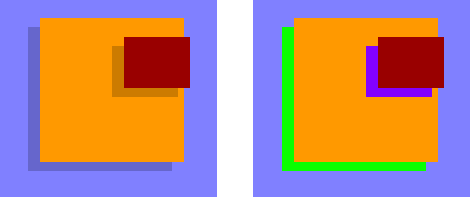Essay 5.1 Why Use Opponent Processes?
We have now seen how the visual system starts out by coding the color of light via the outputs of short, medium, and long wavelength cones (trichromacy). Each cone response is ambiguous on its own, so retinal ganglion cells and LGN neurons combine the output from all three cone types and recode color information in terms of red versus green (R/G), blue versus yellow (B/Y), and black versus white (Bl/Wh) opponent processes. But opponent cell outputs are also ambiguous unless compared against the outputs of different types of opponent cells. So why does the visual system go through the hassle of this recoding process? Why trade one three-dimensional color space (red, green, blue) for another three-dimensional color space (R/G, B/Y, Bl/Wh)?

The image on the left is perceived as three surfaces: a red rectangle above an orange square on a blue background. The image on the right is perceived as five different surfaces. These inferences are easily made on the basis of opponent-process cell outputs.
We cannot know the answer to this question for sure. The human visual system is a product of millions of years of evolution. Careful experimentation can establish how the system works, but experiments cannot tell us why it works the way it does. However, we can speculate about the evolutionary advantage the opponent process outputs might provide over the initial cone outputs. Consider the left-hand image of the figure. You almost certainly perceive this to be a small red rectangle casting a shadow on a large orange square, which in turn is casting a shadow on the pale blue background. But you probably perceive the right-hand image of the figure, which includes exactly the same shapes but with different colors, as five separate surfaces.
The key to making these perceptual inferences is that the areas you interpret as shadows in the left-hand image of the figure are the same hues as their backgrounds, whereas in the right-hand image of the figure all five shapes differ in hue. In terms of cone outputs, the differences between shadows and backgrounds in the left-hand image of the figure will be about as great as the differences between the corresponding areas in the right-hand image of the figure. But in terms of opponent processes, the situation is quite different.
The shadows in the left-hand image of the figure produce exactly the same outputs as their backgrounds in the R/G and B/Y “channels” of the opponent process system. The orange square, for example, activates R+G– and Y+B– cells (because orange can be described as reddish yellow). Since the shadow of the small rectangle is the same hue, it also activates these same opponent process cells. The difference between the shadow and its background will only be registered in the output of the Bl/Wh opponent process: the Wh+Bl– cells will respond more strongly to the brighter orange square than to the darker shadow. In the right-hand image of the figure, on the other hand, all five shapes are different hues, so all five will produce different outputs in the R/G and B/Y channels.
Although we almost never notice them, shadows—brightness differences—are scattered throughout almost every visual scene (if you look around carefully now, you will probably see them everywhere). But shadows are rarely of interest to us, whereas hue boundaries are important. They divide the visual scene into component surfaces which higher-level vision can then combine into objects. Thus, recoding light wavelengths into dimensions that de-emphasize shadows and highlight surfaces—such as the color opponent dimension—is a very good thing.